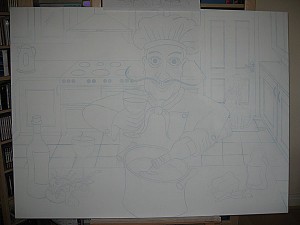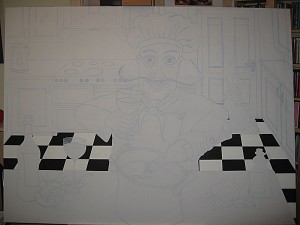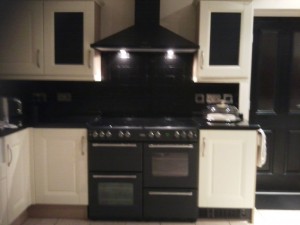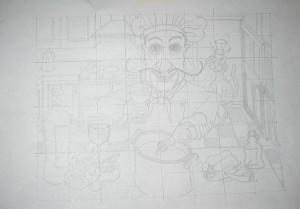Step 5 – Design approved, I’m ready to eat my elephant – here comes the very large acrylic painting…
Large canvas fixed firmly to my easel and gesso primed (I always like to be sure by adding a couple of layers of my own gesso primer, even if they come factory primed) I will scale up my outline sketch from A4 (ish) to A0 size. That’s increasing the size by at least 4-ish times the original.
I remember how, as a child, I would copy pictures in colouring books from one page to another by copying one square at a time from the grid that had been superimposed on the original (with mixed success in the early days and some improvement later on).
Adopting the same methodology, scaling up by a factor of 4 as I go, the sketch is relatively easily transferred to my large canvas using a blue acrylic painted outline.
I selected blue, not simply because it’s my favourite colour, but also because it will provide a good contrast beneath/alongside the layers of neutrals tones I will be painting with very soon.
The picture looks great on its new support, though it’s also strangely daunting now I realise just how much I have to paint to deliver the original design. I hope I have enough paint…this really is a large acrylic painting!!
Step 6 – Breathe deeply and start painting!
My excitement about dealing with the chef and some of the things he is going to cook has to be put aside for now. That’s where I’m allowed the introduction of a small amount of colour, and everything will start to come to life, but for now though, like all good paintings, this one will start with the background.
Starting with the background helps to create the impression that everything is sitting in the right place. I’m going to paint items as though I was building the room, so floor first should ensure that everything else sits properly on top of it and supports the correct sense of perspective. This should mean my chef will “stand” in the middle of the painting in due course both composition and perspective-wise.
Now then, who decided on a checkerboard tiled floor for goodness sake!?
If you’re just too excited to wait for the next instalment you can check out the finished painting in my KL Art Gallery.




